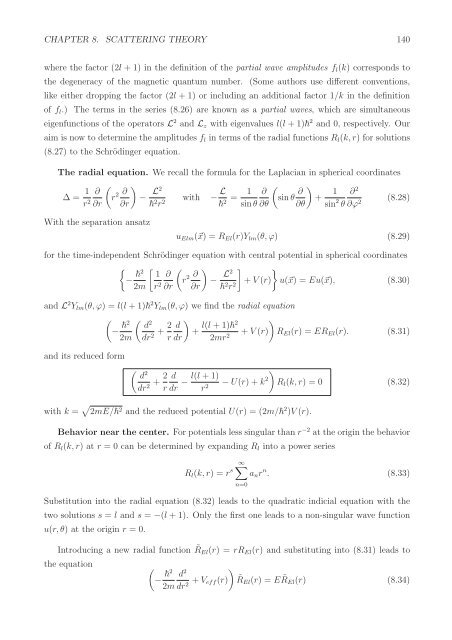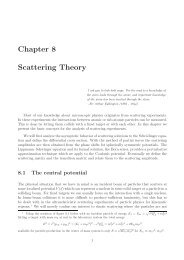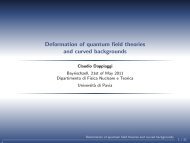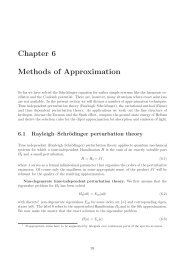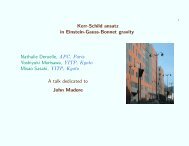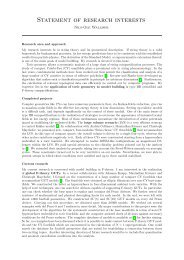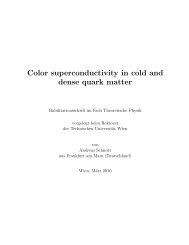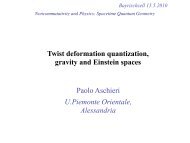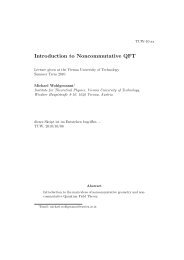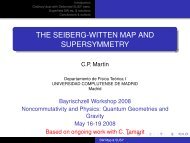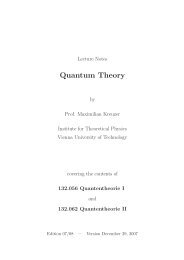Chapter 8 Scattering Theory - Particle Physics Group
Chapter 8 Scattering Theory - Particle Physics Group
Chapter 8 Scattering Theory - Particle Physics Group
Create successful ePaper yourself
Turn your PDF publications into a flip-book with our unique Google optimized e-Paper software.
CHAPTER 8. SCATTERING THEORY 140<br />
where the factor (2l + 1) in the definition of the partial wave amplitudes f l (k) corresponds to<br />
the degeneracy of the magnetic quantum number. (Some authors use different conventions,<br />
like either dropping the factor (2l + 1) or including an additional factor 1/k in the definition<br />
of f l .) The terms in the series (8.26) are known as a partial waves, which are simultaneous<br />
eigenfunctions of the operators L 2 and L z with eigenvalues l(l + 1) 2 and 0, respectively. Our<br />
aim is now to determine the amplitudes f l in terms of the radial functions R l (k,r) for solutions<br />
(8.27) to the Schrödinger equation.<br />
The radial equation. We recall the formula for the Laplacian in spherical coordinates<br />
∆ = 1 (<br />
∂<br />
r 2 ∂ )<br />
− L2<br />
with − L r 2 ∂r ∂r 2 r 2 = 1 (<br />
∂<br />
sin θ ∂ )<br />
+ 1 ∂ 2<br />
2 sin θ ∂θ ∂θ sin 2 (8.28)<br />
θ ∂ϕ 2<br />
With the separation ansatz<br />
u Elm (⃗x) = R El (r)Y lm (θ,ϕ) (8.29)<br />
for the time-independent Schrödinger equation with central potential in spherical coordinates<br />
[ (<br />
{− 2 1 ∂<br />
r 2 ∂ ) ] }<br />
− L2<br />
+ V (r) u(⃗x) = Eu(⃗x), (8.30)<br />
2m r 2 ∂r ∂r 2 r 2<br />
and L 2 Y lm (θ,ϕ) = l(l + 1) 2 Y lm (θ,ϕ) we find the radial equation<br />
( (− 2 d<br />
2<br />
2m dr + 2 ) )<br />
d l(l + 1)2<br />
+ + V (r) R 2 r dr 2mr 2<br />
El (r) = ER El (r). (8.31)<br />
and its reduced form<br />
( d<br />
2<br />
dr 2 + 2 r<br />
)<br />
d l(l + 1)<br />
− − U(r) + k 2 R<br />
dr r 2 l (k,r) = 0 (8.32)<br />
with k = √ 2mE/ 2 and the reduced potential U(r) = (2m/ 2 )V (r).<br />
Behavior near the center. For potentials less singular than r −2 at the origin the behavior<br />
of R l (k,r) at r = 0 can be determined by expanding R l into a power series<br />
∑ ∞<br />
R l (k,r) = r s a n r n . (8.33)<br />
Substitution into the radial equation (8.32) leads to the quadratic indicial equation with the<br />
two solutions s = l and s = −(l + 1). Only the first one leads to a non-singular wave function<br />
u(r,θ) at the origin r = 0.<br />
Introducing a new radial function ˜R El (r) = rR El (r) and substituting into (8.31) leads to<br />
the equation (<br />
− 2<br />
2m<br />
n=0<br />
)<br />
d 2<br />
dr + V eff(r) ˜R 2 El (r) = E ˜R El (r) (8.34)


